陆空通话1
- 格式:pdf
- 大小:211.63 KB
- 文档页数:6
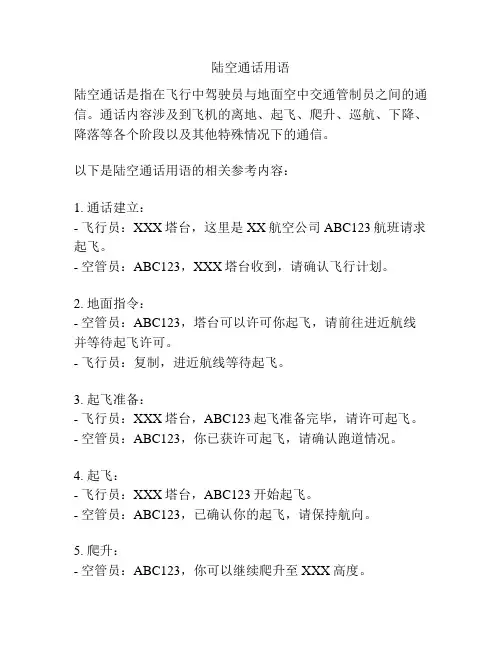
陆空通话用语陆空通话是指在飞行中驾驶员与地面空中交通管制员之间的通信。
通话内容涉及到飞机的离地、起飞、爬升、巡航、下降、降落等各个阶段以及其他特殊情况下的通信。
以下是陆空通话用语的相关参考内容:1. 通话建立:- 飞行员:XXX塔台,这里是XX航空公司ABC123航班请求起飞。
- 空管员:ABC123,XXX塔台收到,请确认飞行计划。
2. 地面指令:- 空管员:ABC123,塔台可以许可你起飞,请前往进近航线并等待起飞许可。
- 飞行员:复制,进近航线等待起飞。
3. 起飞准备:- 飞行员:XXX塔台,ABC123起飞准备完毕,请许可起飞。
- 空管员:ABC123,你已获许可起飞,请确认跑道情况。
4. 起飞:- 飞行员:XXX塔台,ABC123开始起飞。
- 空管员:ABC123,已确认你的起飞,请保持航向。
5. 爬升:- 空管员:ABC123,你可以继续爬升至XXX高度。
- 飞行员:复制,继续爬升至XXX高度。
6. 巡航:- 飞行员:XXX塔台,ABC123到达巡航高度,请告知下一阶段指令。
- 空管员:ABC123,已确认,你可以在巡航高度飞行。
7. 下降:- 空管员:ABC123,你可以开始下降至XXX高度。
- 飞行员:复制,开始下降至XXX高度。
8. 进近:- 飞行员:XXX塔台,ABC123进入进近航线。
- 空管员:ABC123,已确认,注意保持你的降落航路。
9. 复飞:- 飞行员:XXX塔台,ABC123计划复飞,请提供指令。
- 空管员:ABC123,明白,你可以执行复飞程序。
10. 降落:- 空管员:ABC123,你已获准降落,请注意跑道情况。
- 飞行员:复制,注意跑道情况。
11. 地面滑行:- 飞行员:XXX塔台,ABC123请求滑行至指定停机位。
- 空管员:ABC123,你已获准滑行至指定停机位。
12. 关闭引擎:- 飞行员:XXX塔台,ABC123已关机。
- 空管员:感谢合作,ABC123。
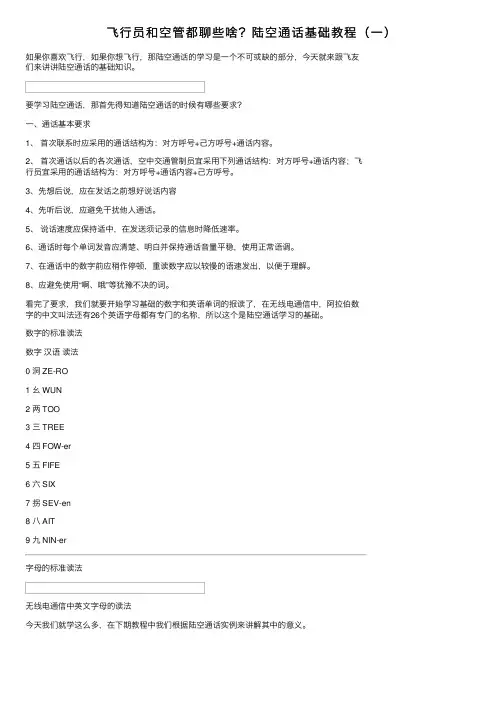
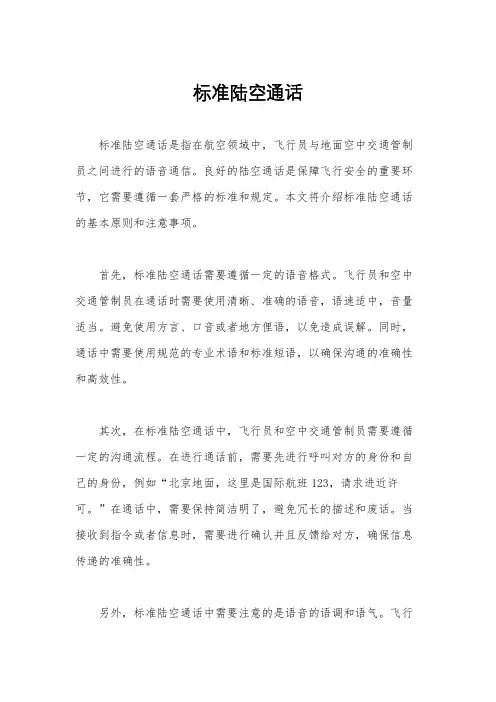
标准陆空通话标准陆空通话是指在航空领域中,飞行员与地面空中交通管制员之间进行的语音通信。
良好的陆空通话是保障飞行安全的重要环节,它需要遵循一套严格的标准和规定。
本文将介绍标准陆空通话的基本原则和注意事项。
首先,标准陆空通话需要遵循一定的语音格式。
飞行员和空中交通管制员在通话时需要使用清晰、准确的语音,语速适中,音量适当。
避免使用方言、口音或者地方俚语,以免造成误解。
同时,通话中需要使用规范的专业术语和标准短语,以确保沟通的准确性和高效性。
其次,在标准陆空通话中,飞行员和空中交通管制员需要遵循一定的沟通流程。
在进行通话前,需要先进行呼叫对方的身份和自己的身份,例如“北京地面,这里是国际航班123,请求进近许可。
”在通话中,需要保持简洁明了,避免冗长的描述和废话。
当接收到指令或者信息时,需要进行确认并且反馈给对方,确保信息传递的准确性。
另外,标准陆空通话中需要注意的是语音的语调和语气。
飞行员和空中交通管制员需要保持一种专业、礼貌的态度,避免情绪化的表达和冲突性的语言。
在面对紧急情况或者突发事件时,需要保持冷静,清晰地传达信息,并且及时采取相应的措施,确保飞行安全。
最后,在标准陆空通话中,需要遵循一定的安全原则。
飞行员和空中交通管制员需要严格遵守通信程序和规定,严禁私自更改飞行计划或者违反指令。
在通话中需要密切关注飞行情况和气象变化,及时传达信息并且调整飞行计划,确保飞行安全。
总之,标准陆空通话是航空领域中不可或缺的一环,它直接关系到飞行安全和航空运输的顺畅进行。
飞行员和空中交通管制员需要严格遵守通话规范和流程,保持良好的沟通状态,确保飞行任务的顺利完成。
希望各位飞行员和空中交通管制员能够在实际工作中严格遵守标准陆空通话的相关规定,共同维护航空安全。
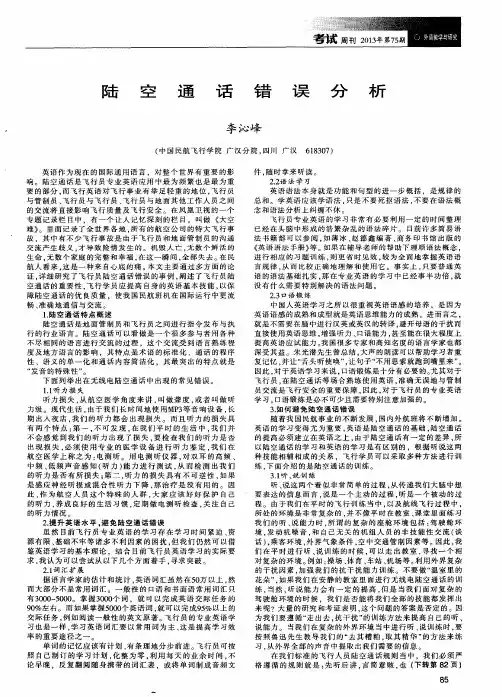
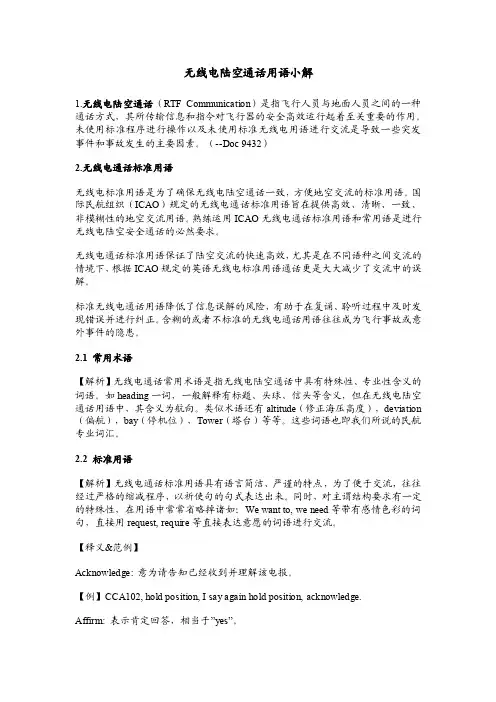
无线电陆空通话用语小解1.无线电陆空通话(RTF Communication)是指飞行人员与地面人员之间的一种通话方式,其所传输信息和指令对飞行器的安全高效运行起着至关重要的作用。
未使用标准程序进行操作以及未使用标准无线电用语进行交流是导致一些突发事件和事故发生的主要因素。
(--Doc 9432)2.无线电通话标准用语无线电标准用语是为了确保无线电陆空通话一致,方便地空交流的标准用语。
国际民航组织(ICAO)规定的无线电通话标准用语旨在提供高效、清晰、一致、非模糊性的地空交流用语。
熟练运用ICAO无线电通话标准用语和常用语是进行无线电陆空安全通话的必然要求。
无线电通话标准用语保证了陆空交流的快速高效,尤其是在不同语种之间交流的情境下,根据ICAO规定的英语无线电标准用语通话更是大大减少了交流中的误解。
标准无线电通话用语降低了信息误解的风险,有助于在复诵、聆听过程中及时发现错误并进行纠正。
含糊的或者不标准的无线电通话用语往往成为飞行事故或意外事件的隐患。
2.1 常用术语【解析】无线电通话常用术语是指无线电陆空通话中具有特殊性、专业性含义的词语。
如heading一词,一般解释有标题、头球、信头等含义,但在无线电陆空通话用语中,其含义为航向。
类似术语还有altitude(修正海压高度),deviation (偏航),bay(停机位),Tower(塔台)等等。
这些词语也即我们所说的民航专业词汇。
2.2 标准用语【解析】无线电通话标准用语具有语言简洁、严谨的特点,为了便于交流,往往经过严格的缩减程序,以祈使句的句式表达出来。
同时,对主谓结构要求有一定的特殊性,在用语中常常省略掉诸如:We want to, we need等带有感情色彩的词句,直接用request, require等直接表达意愿的词语进行交流。
【释义&范例】Acknowledge: 意为请告知已经收到并理解该电报。
【例】CCA102, hold position, I say again hold position, acknowledge.Affirm: 表示肯定回答,相当于”yes”。

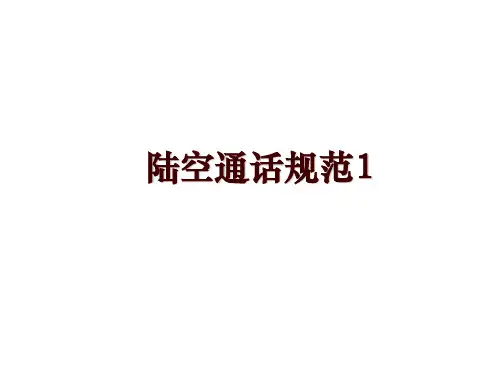
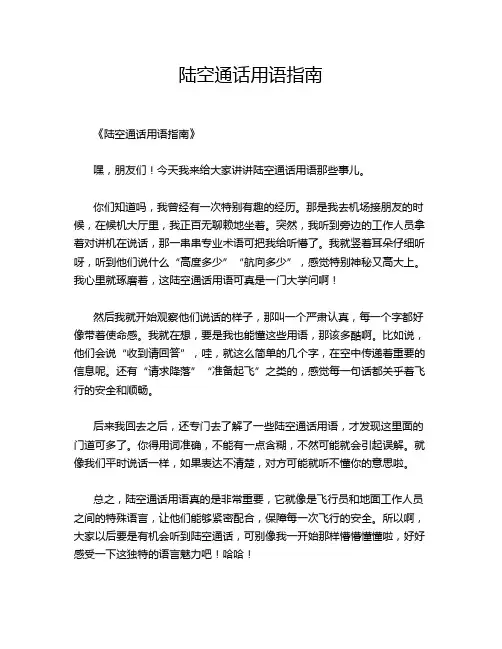
陆空通话用语指南
《陆空通话用语指南》
嘿,朋友们!今天我来给大家讲讲陆空通话用语那些事儿。
你们知道吗,我曾经有一次特别有趣的经历。
那是我去机场接朋友的时候,在候机大厅里,我正百无聊赖地坐着。
突然,我听到旁边的工作人员拿着对讲机在说话,那一串串专业术语可把我给听懵了。
我就竖着耳朵仔细听呀,听到他们说什么“高度多少”“航向多少”,感觉特别神秘又高大上。
我心里就琢磨着,这陆空通话用语可真是一门大学问啊!
然后我就开始观察他们说话的样子,那叫一个严肃认真,每一个字都好像带着使命感。
我就在想,要是我也能懂这些用语,那该多酷啊。
比如说,他们会说“收到请回答”,哇,就这么简单的几个字,在空中传递着重要的信息呢。
还有“请求降落”“准备起飞”之类的,感觉每一句话都关乎着飞行的安全和顺畅。
后来我回去之后,还专门去了解了一些陆空通话用语,才发现这里面的门道可多了。
你得用词准确,不能有一点含糊,不然可能就会引起误解。
就像我们平时说话一样,如果表达不清楚,对方可能就听不懂你的意思啦。
总之,陆空通话用语真的是非常重要,它就像是飞行员和地面工作人员之间的特殊语言,让他们能够紧密配合,保障每一次飞行的安全。
所以啊,大家以后要是有机会听到陆空通话,可别像我一开始那样懵懵懂懂啦,好好感受一下这独特的语言魅力吧!哈哈!
这就是我关于陆空通话用语的一点小分享,希望能让大家对这个神秘的领域多一些了解和兴趣哟!。
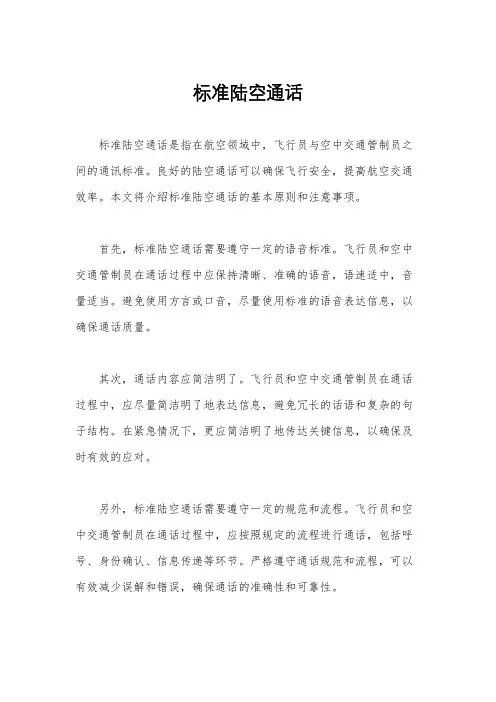
标准陆空通话
标准陆空通话是指在航空领域中,飞行员与空中交通管制员之间的通讯标准。
良好的陆空通话可以确保飞行安全,提高航空交通效率。
本文将介绍标准陆空通话的基本原则和注意事项。
首先,标准陆空通话需要遵守一定的语音标准。
飞行员和空中交通管制员在通话过程中应保持清晰、准确的语音,语速适中,音量适当。
避免使用方言或口音,尽量使用标准的语音表达信息,以确保通话质量。
其次,通话内容应简洁明了。
飞行员和空中交通管制员在通话过程中,应尽量简洁明了地表达信息,避免冗长的话语和复杂的句子结构。
在紧急情况下,更应简洁明了地传达关键信息,以确保及时有效的应对。
另外,标准陆空通话需要遵守一定的规范和流程。
飞行员和空中交通管制员在通话过程中,应按照规定的流程进行通话,包括呼号、身份确认、信息传递等环节。
严格遵守通话规范和流程,可以有效减少误解和错误,确保通话的准确性和可靠性。
此外,标准陆空通话还需要遵守一定的礼仪。
飞行员和空中交
通管制员在通话过程中,应保持礼貌和尊重,避免使用粗鲁或不当
的语言,尊重对方的权威和专业。
良好的礼仪可以促进良好的沟通
氛围,提高通话效率。
总之,标准陆空通话是航空领域中非常重要的一环,对飞行安
全和航空交通效率有着重要的影响。
飞行员和空中交通管制员需要
严格遵守通话的语音标准、内容简洁、规范流程和良好礼仪,以确
保通话质量和航空安全。
希望广大从业人员能够重视标准陆空通话,不断提高通话技能,为航空事业的发展贡献自己的力量。

Part I ListeningSection IDirections:In this part you will hear ten ATC clearances\instructions or statements, each ATC clearances\instructions or statements will be spoken only once. A question will be asked after each ATC clearances\instructions or statements, there are four answers marked a,b,c,and d, choose the most appropriate answer from the four choices according to what you have heard .1.Air China 102, cleared to Beijing via Bekol, flight planned route, maintain 7000 feet, Bekol two CharlieDeparture, request level change en route for 10,200 m, squawk 5325.Question: What is the SID procedure?a. Bekol two sevenb. Bekol one Charliec. Charlie two sevend. Bekol two CharlieCorrect answer: d2.All aircrafts Rexbury Control, fuel dumping in progress, DC 8, on radial 240 Forest VOR, ranging 14 to 20nm, avoid below dumping track.Question: What happened?a.All aircrafts are avoiding fuel dumping.b. A DC 8 is dumping fuel.c.All aircrafts are flying below dumping area.d. A DC 8 is flying below dumping area.Correct answer: b3.Ground, Danair 432 is ready to go, but the tow bar has broken, is it O.K if we are a few minutes late? Question: What is the problem?a.Danair 432 is a few minutes late.b.Danair 432 is ready for takeoff.c.Danair 432 has taken off.d.Danair 432 has a tow bar problem.Correct answer: d4.Sabena 421, will you make a one eighty and backtrack to vacate on the 08 fast turn-off, there is a fire truck onthe fast turn-off.Question: What should the pilot do?a.To exit the runway on 180 fast rapid exit.b.To exit the runway on 08 rapid exit.c.To turn off on backtrack.d.To turn off after the fire truck.Correct answer: b5.When you get to the threshold you can count the lights from there to check the actual visibility.Question: What do you learn from this statement?a.Lights can be counted from the threshold.b.Visibility can be measured from the threshold.c.Lights on the runway can be used to measure visibility.d.Visibility can be checked from the threshold.Correct answer: c6.KLM 316, London, commence your descent to cross Clacton at FL 170, expedite through FL 210. Question: What is the controller’s instruction?a.Descend to FL170.b.Descend to FL 210.c.Climb to FL 170.d.Climb to FL 210.Correct answer: a7.You have a traffic 10 o’clock 6 miles heading 150 Boeing 747 two thousand feet above.Question: What is the position of the intruding aircraft?a.10 o’clock, 6 miles 2000 feet aboveb. 6 o’clock, 10 miles, 2000 feet abovec.10 o’clock, 6 miles, 1000 feet aboved. 6 o’clock, 10 miles, 1500 feet aboveCorrect answer: a8.There is a squall line expected to develop in the vicinity of Newton moving eastward about 30 kt, moderate tolocally severe turbulence spreading along the squall line with strong and gusty surface winds, they expect a tornado in the Warton area around 3 miles diameter, surface winds with gusts of 65, extreme turbulence, scattered cumulo-nimbus with maximum tops to 50,000, this extends to 50 miles northwest of Mansfield. Question: What will be the most important factor to influence the flight?a.High windb.Severe turbulencec.Gusty surface windsd.Squall lineCorrect answer: b9.Delta 253, resume your own navigation, direct Farmington, rest of route remains unchanged, maintain flightlevel 390.Question: What should pilots do?a.Change the flight route.b.Maintain the flight route.c.Resume level 253.d.Resume level 390.Correct answer: b10.China Southern 3041, we’ve just been caught in severe turbulence about 15 passengers have been hurt; we’llhave to divert to Guangzhou. Request medical assistance on landing.Question: What do the crew need after they have landed?a.Turbulence avoidance.b.Passenger assistance.c.Diversion instruction.d.Ambulance ready.Correct answer: dSection IIDirections: In this part you will hear five RTF exchanges between pilots and air traffic controllers, each exchange will be spoken only once. A question will be asked after each exchange, there are four answers marked a,b,c,and d, choose the most appropriate answer from the four choices according to what you have heard .1.PIL: KLM 341 just over the outer marker.CTL: 341, landing clearance in 30 seconds, continue your approach, previous aircraft report windshear in the last 300 feet of the final approach, with an airspeed loss of 15 kts.PIL: 341, roger. It’s a bit bumpy up here.少量颠簸CTL: Er, roger, 341, I’d appreciate your comments on the windshear after landing.Question: What do you learn from the conversation?a.The pilot expects the controller to provide the information about the windshear.b.The controller hopes the pilot to describe the windshear.c.The pilot hopes the controller to describe the windshear.d.The controller wants the pilot to describe the windshear encountered by the previous plane.Correct answer b2.PIL: Northwest 552 is established on the ILS for 26.TWR: 552, report outer marker, wind 360 20 kts, gusting 30 kts.PIL: 552.PIL: Northwest 552, we have undercarriage trouble. We would like to go around.TWR: Climb 2000 feet and turn left heading 200.PIL: 2000 feet, left 200 degrees, 552.TWR: Do you intend to make another approach straight away or to hold somewhere?PIL: I’ll have to hold for a while to sort this out.TWR: OK. Climb 3000 feet and proceed to SEL. Contact approach now on 121.6.PIL: 3000 feet, 121.6, 552.Question: What is the pilot’s intention?a.To make another straight in approach.b.To go around to find what the trouble is.c.To go around and contact approach on 121.65.d.To go around and try to solve the problem.Correct answer: d3.PIL: Chengdu Control, Air China 4401, we are unable to control pressurization, cabin altitude is rising fast,request immediate descent to 4800m.CTL: Air China 4401 descend to 4800m, report reaching.PIL: Descending to 4800m, Air China 4401.PIL: Air China 4401, reaching 4800m.CTL: Air China 4401, what’s your intention?PIL: Resume our flight to Xi’an, 4401.Question: What will the crew do after the immediate descent?a.Resume to the reporting pointb.Resume to the planned alternatec.Resume to the planned destinationd.Resume to flight level 120Correct answer: c4.CTL: China Southern 302 Hong Kong, cleared to Bekol flight level 160, cross Bekol flight level 130 orabove.PIL: Hong Kong, China Southern 302, unable to comply, can not cross Bekol flight level 130 due weight.Question: Why cannot the pilot follow the controller’s instruction?a.Can not climb to 130.b.Can not cross Bekol.c.Can not reach the assigned level due wait.d.Can not reach the assigned level due loading.Correct answer: d5.P: Hong Kong approach, China Southern 303, we have been struck by lightening雷击, rear fuselage damaged,right elevator lost, request priority landing and radar vector to final approach.C: China Southern 303, you are number one, radar will assist you until landing.Question: Why does the pilot ask for priority landing?a.fuselage damageb.both elevator lostc.right fuselage damaged.both flaps lostCorrect answer: aSection IIIDirections: In this section you will hear two passages. each passage will be spoken only once. After each passage five questions will be asked, for each question there are four answers marked a,b,c,and d, choose the most appropriate answer from the four choices according to what you have heard .Passage I(The crew of flight 523 found a traffic 20 miles at FL 294 right ahead of the airplane on TCAS at FL 290 near LAMEN. The captain reported to Shanghai Control immediately, but the controller responded that there was no indication on his radar screen and there had not been any flight advisory. The captain then instructed the crew to turn left and found the conflicting traffic closing to the flight path and a TCAS warning was initiated. The crew then immediately turn right for avoidance, disengage the autopilot and descended to a lower altitude. The crew reported to the controller about the conflict after the conflict had been cleared.)The following questions are based on the passage you have just heard.Questions:1.What did the crew of flight 523 do when a conflicting traffic was found?A. The crew initiated the TCASB. The captain reported to the controllerC. The captain found no indicationD. The captain instructed at once.on the radar screencorrect answer: b2.What is the response of the controller when the conflict occurred?A.He found an indication on the screenB.He instructed the crew to descend to a lower altitude.C.He found no indication on the screen.D.He instructed the crew to turn right to avoid.correct answer: c3.What is the height of the intruding闯入,侵入airplane?A.FL290B.FL294C.FL523D.FL253correct answer: b4.Why did the crew immediately turn right when the intruding aircraft got close?a.to avoid conflictb.to disengage the autopilotc.to descend to a lower altituded.to resume to own navigationcorrect answer: a5.What did the crew do after the conflict was cleared?a.report to the controllerb.resume to own navigationc.descend to the original altituded.maintain headingcorrect answer: aPassage IIBeijing Capital Airport A TIS information alpha, 0300 hours. Expect ILS approach runway 36 left, runway surface wet. Work in progress near beginning of runway 36 left, taxiway papa closed. Wind 035 degrees 6 metres per second. CA VOK, temperature 30, dew point 24, QNH 1010, no sig. On initial contact advise you have information alpha.The following questions are based on the passage you have just heard.1.What is the runway surface condition?a.wetb.sandyc.dryd.unavailablecorrect answer: a2.Why is taxi way papa closed?a.runway surface wetb.traffic congestionc.work in progressd.time limitcorrect answer: c3.What is the altimeter setting value?a.QNH 1001b.QFE1001c.QHN1010d.QFE1010Correct answer c4.Which runway is in use?a.30 leftb.36 leftc.30 rightd.36 rightcorrect answer:b5.What is the wind components成分的?a.360 6b.350 6c.300 5d.350 5correct answer aSection IV现学到这Directions:In this section there are some ATC clearances\instructions or pilot’s reports\requests. These above words are spoken only once. In each spoken part some words are missing. Listen carefully and fill the blanks with what you have just heard.1. GBHJU an Airbus is becoming about________ o'clock twelve miles now another pilot reports he's reallylooking pretty bad there ahead and to________, do you see him?GBHJU an Airbus is becoming about eleven o'clock twelve miles now another pilot reports he's really looking pretty bad there ahead and to your right, do you see him?2.Air China 101 reporting __________. We have just _________that crossed our course about. 100 feet belowAir China 101 reporting an airmiss. We have just missed colliding with an aircraft that crossed our course about 100 feet below3.GACSD cleared from B airport to S airport, _________ flight planned route, Climb and maintain _________,for departure squawk 4356.GACSD cleared from B airport to S airport direct BNV, flight planned route, Climb and maintain 10200 meters, for departure squawk 4356.4.GOP code changed and identification___________. Cross BIPOP at 7200 meters, when ready descend andmaintain___________.GOP code changed and identification observed. Cross BIPOP at 7200 meters, when ready descend and maintain 3000 meters.5. All stations, B control. _________in progress over DACFP at 9000 meters by Airbus heading 210 inbound,left traffic. All aircraft avoid this area below 10000 meters within _________All stations, B control. Fuel dumping in progress over DACFP at 9000 meters by Airbus heading 210 inbound, left traffic. All aircraft avoid this area below 10000 meters within 15 kilometers of track.Section VDirections: In this section there is an exchange between pilots and controllers, the exchange will be spoken only once. Listen carefully and then complete the table below.1.East Flight 121 was leaving FL___2.The trouble of East Flight 121_____ ___________.3.ATC issued a block levels to East Flight 121 between 250 and ___________.4.East Flight 121 intended to land__ ________________.5.East Flight121 needed to descend down to change my___________ make sure I can control the jet.1.East Flight 121 was leaving FL___250__________2.The trouble of East Flight 121_____ lost vertical control of our airplane ___________.3.A TC issued a block levels to East Flight 121 between __250___and ___200________.4.East Flight 121 intended to land__ New Island ________________.5.East Flight121 needed to descend down to change my configuration make sure I can control the jet.__________.Part II Oral InteractionSection One: Normal ProcedureDirections: In this part, you are a pilot. Your aircraft callsign is ABCDE. Your flight is from Bluenard to Greenard , alternate is Blackyard. Complete your communication with A TC according to the controllers instructions and the prompt. Your voice will be recorded when you see a microphone on the screen.A. Pre-flight1. ( you are on GateB15, you ‘ve got information K, please contact Blueyard Delivery, request your A TC clearance.)P: Blueyard Delivery, ABCDE We have got information K, request ATC clearance.2. C: ABCDE, Blueyard Delivery, you are cleared to Greenard Airport via flight planned route, Coly 1D Departure, initially climb to 3000ft. Request level change en route, Squawk 5127, contact Ground control 121.7.P: cleared to Greenard Airport via flight planned route, Coly 1D Departure, initially climb to 3000ft. Request level change en route, Squawk 5127, 121.7 ABCDE.3.(Before start-up, the dispatching officer send the loadsheet for you. When you verify the loadsheet you foundsome mistakes, there is a 5600kg difference between the actual payload and the calculated figure on the loadsheet. You point it out and ask him for verify.)P: Hello, sir. I found some mistakes here. The two numbers have a big difference. The actual payload and the calculated figure here has a 5600kg difference. Would you please check it?4.(Now, you contact with Ground, request push-back and start-up.)P: Blueyard Ground, ABCDE. Good morning, Gate B15, information K, 10 minutes before start-up, request push-back and start-up for Greenard.5.C: ABCDE, Ground push-back and start-up approved, facing North.P: Push-back and start-up approved, facing north, ABCDE.B. Departure6. (Call Ground, you are ready for taxi)P: Blueyard Ground ABCDE ready for taxi information K7. C: ADE taxi to holding point r/w26R wind080/8(you want taxi instruction)P: ADE request detail taxi instruction to r/w26R8. C: ADE taxiway T A A7 to holding point r/w 26R.P: taxi way T A A7 to holding point r/w26R ADE9. C: ADE hold short of taxiway A give way to airbus passing left to rightP: Holding short of taxiway A traffic in sight ADE10. C: ADE continue taxi expedite aircraft behind youP: Expediting ADE11. C: ADE Contact Blueyard Tower on 118.1 Good-day.P: 118.1, good-day.12.(Call Tower)P: Blueyard Tower, ABCDE Good morning13.C: ABCDE hold short of r/w, report the B747 on final in sight.P: Holding short, traffic in sight, ABCDE.14.C: ADE, line up and wait.P: Lining up and wait, ADE.15.(you have commenced Coly1D departure contact departure)P: Blueyard Departure ABCDE follow Coly1D departure climbing16.C: ABCDE continue to follow Coly1D departure climb to 7000ftP: following Coly1D departure climb to 7000ft ADE17. C: ADE continue to climb 9000ft after passing DR, contact Blueyard Control 131.75.P: continue to climb 9000ft after passing DR, contact Blueyard control 128.3 ADEC. En-route18. (contact Blueyard control)P: Blueyard control ABCDE19.C: sorry say again call signP: Blueyard control ABCDEC: pass your messag.20. (report you are over FVL at45 FL250 ETO ECT at05)P: ABCDE FVL 45 FL250 estimating ECT 0521.C: ADE climb to and maintain FL 330 repot reachingP: climbing to and maintain FL330 report reaching ADE22. (you reaching FL330)P: ADE level at FL33023. (These is no response from A TC, you have a transmitting failure, you decide to transmitting blind. Yourposition 80 miles west of NGT at FL330 ETO YEL 30)P: All stations ABCDE transmitting blind ADE 80 miles west of NGT FL330 ETO YEL30 transmitting blind ABCDE 80 miles west of NGT FL330 ETO YEL30D. Descent24. Contact Greenard control you are fly at FL350 ready for descent)P: Blueyard control ABCDE FL350 ready for descent25.C: ABCDE for identification make one right hand orbitP: orbiting right ABCDE26.C: ADE radar contact after passing OMI descent to 9000ft, contact Greenard Approach on 118.5 Good day. P: after passing OMI descent to 9000ft 118.5 Good day ADE27. (you are now over OMI at 45 ETO BOV 55, contact Approach)P: Greenard Approach ABCDE OMI at 45 ETO BOV 55, descending28.C: ABCDE continue descend to 3000ft QNH 1005 reduce speed to 250kts.P: descending to 3000ft, ABCDE29.(you are reaching 3000ft)P: Greenard Approach ABCDE reaching 3000ft30. C: ADE descend to and maintain 2000ft, expect ILS approach r/w 35L, QNH1005, report established.P: Descending to and maintain 2000ft ILS approach r/w 35L ADEE. Landing and after landing31. (you have established on the r/w35L)P: Approach ADE established.32.C: ADE you are No.1, contact Tower on 119.9 good day.P: 119.9 good day ADE33. (You have landed and vacate the r/w, call Greenard Ground)P: Greenard ground ABCDE good morning r/w vacated34. C: ABCDE taxi straight ahead hold short of twAP: taxi straight ahead hold short of twA ABCDE35.C: ADE twA2, then turn right into your parking position stand 15P: twA2 right turning into stand 15 ADE36.C: ADE hold short of twA2 give way to 737 passing left to rightP: holding short 737 in sight ADE37. (you seem to have had a nose gear tyre blow out, report to Ground control you need a tug to tow you back tothe apron.)P: Ground ADE we seem to have had a nose gear tyre blow out, request a tug to tow us back the apron.38. C: ADE can you move forward under your own power, 50 yards or so until you’re past the next intersection?P: Stand by39. (You say you can manage that slowly)P: Affirm, I think we can manage that slowly ADE40. C: ADE we’ll get a tug out to you in 5 minutes.P: Thank you ADESection Two: Abnormal ProcedureDirections:. In this part, you are a pilot. Your aircraft callsign is ABCDE. Complete your communication with ATC according to the controllers instructions and the prompt. Your voice will be recorded when you see a microphone on the screen.Item 1CTL: ABCDE, Blueyard Tower, you are cleared for take off. Surface wind 090 degrees, 8 knots.PIL: Roger, understand cleared to line up and take off, ADE(You have an engine failure,report the problem )PIL:Blueyard Tower, we have an engine failure.ADECTL: ADE, your intention.PIL: (You’d like to return for landing before dumping) ADE, we'll go out and dump fuel and return.CTL: ADE roger.Item 2(Because of engine failure during take off, you are now climbing to dump fuel)CTL: ABCDE, Report your altitude.PIL: (Say you are through 1000ft) We are climbing through 1000 feet.CTL: ADE,I suggest you . Roger. turn on to an easterly heading and climb to about 5000 feet before commencing dumping fuel.PIL: ADE, we'll turn on to an easterly heading and climb to about 5000 feet.CTL: Roger.PIL:(Report to Blueyard Approach you are not able to dump fuel due to engine fire) Blueyard Approach. ADE, we won't be able to dump. We've got an engine on fire at this time.CTL: ADE, Your intentions.PIL: (Say to land with fuel on board)We'll have to come back and land with the fuel on board.APP: Roger ADE.Item3(Because of engine fire after take-off, you are coming back to land with fuel on board , contact Blueyard Approach)PIL: Blueyard Approach.ADE We are coming back to land with fuel on board.CTL: Roger ADE, make a right turn I say again a right turn on to heading 260PIL: Right turn on to 260, ADE.CTL: Affirm, right turn heading 260. I'll vector you straight in on to Runway 26R, no delay.PIL: Runway 26R, ADEPart III Oral ResponsesNarrationDirections: In this part, you are going to listen to two accident narratives, after each narrative three questions will be asked, make your answer be recorded when you see a microphone on the screen.Accident narrativeOn 6 July 1962, an Alitalia DC-8 (Flight 771) crashed near Junnar, India. The accident was caused by a navigation error which led the pilot to believe that he was nearer his destination than he actually was and, therefore, caused him to make a premature descent in instrument conditions for a straight-in approach to land at night. Theaircraft consequently, crashed into high terrain. Contributing causes were: 1) Failure on the part of the pilot to make use of the navigational facilities available in order to ascertain the correct position of the aircraft. 2) violation of the prescribed minimum safe altitude. 3) Unfamiliarity of the pilot with the terrain on the route.Question 1:According to the narrative, what are the causes of the accident?Question 2:Describe the accident in your own words based on the given information and the text you hear. Question 3: what lessons have your learned from the accident?。

陆空通话用语指南
1. 通话开始
- "______航空站,这里是______陆站,请求通话。
"
- "______陆站,这里是______航空站,收到您的呼叫,请讲。
"
2. 报告天气和跑道情况
- "当前天气情况如下:..."
- "跑道______可用,跑道视程为______米。
"
3. 请求起飞/着陆许可
- "______航空站,这里是______航班,请求起飞/着陆许可。
"
- "______航班,获准起飞/着陆,使用跑道______。
"
4. 报告航班位置
- "______航空站,这里是______航班,目前位置______。
"
- "______航班,已确认您的位置。
"
5. 紧急情况处理
- "______航空站,这里是______航班,遇到紧急情况,请求协助。
" - "______航班,请立即说明情况,我们将提供必要协助。
"
6. 通话结束
- "______航空站,这里是______陆站,通话结束。
"
- "______陆站,这里是______航空站,已收到,通话结束。
"
注意:
- 通话时请保持专业、简洁和清晰的语言表达。
- 遵守相关的航空通话规则和程序。
- 在紧急情况下,请保持冷静并提供准确信息。
标准陆空通话首先,标准陆空通话的重要性不言而喻。
飞行器在空中飞行时,飞行员和地面控制人员之间的通话是唯一的联系方式。
良好的通话可以帮助飞行员及时获取飞行任务、气象信息、空中交通情况等重要信息,从而做出正确的决策。
同时,飞行员也需要向地面控制人员报告飞行情况,以便地面控制人员做好航空交通管制工作。
因此,标准的陆空通话对于飞行安全至关重要。
其次,标准陆空通话的基本原则包括准确、简洁、规范。
准确是指通话内容必须清晰明了,不得含糊不清,以免产生误解。
简洁是指通话内容要言之有物,不得啰嗦冗长,以免浪费时间和频率资源。
规范是指通话用语必须符合规定的标准,不得使用俚语或口头语,以免引起歧义。
遵循这些基本原则可以有效地提高通话的质量,减少通信失误的可能性。
最后,以下是一些常用的标准陆空通话用语:1. 起飞许可,Ground, this is Flight 123, request takeoff clearance.地面,这里是123航班,请求起飞许可。
2. 空中交通管制,Control, this is Flight 123, request permission to climb to FL 350.管制,这里是123航班,请求升至35000英尺的许可。
3. 气象信息,Tower, this is Flight 123, request current weather at destination airport.塔台,这里是123航班,请求目的地机场的当前天气信息。
4. 紧急情况,Mayday, mayday, mayday. This is Flight 123, declaring an emergency, engine failure.紧急情况,紧急情况,紧急情况。
这里是123航班,宣布发生紧急情况,发动机故障。
5. 着陆许可,Tower, this is Flight 123, request permission to land, runway 27L.塔台,这里是123航班,请求着陆许可,27L跑道。
民用航空无线电陆空通话中文用语教材(实用版)适用范围:模拟飞行及模拟管制爱好者教学范围:常规性通话教学形式:范例型第一章基础知识第一节通话注意事项1、发话以前先想好说话内容。
2、应避免干扰他人通话。
3、应稳定按住发话键再开始说话。
4、语速应保持适中。
5、发音清晰,语意明了,通话音量稳定。
6、数字前应稍作停顿,以稍慢的语速重读数字。
7、应避免“啊”、“哦”等犹豫不决的词。
8、保证通话内容的完整性。
第二节通话结构1、首次联系时:对方呼号+己方呼号+通话内容2、首次通话以后,管制员各次联系时:对方呼号+通话内容3、飞行员复诵管制员通话内容时:通话内容+己方呼号4、飞行员向管制员报告时:己方呼号+通话内容第三节数字和字母的发音数字发音如下:数字组合读法如下米制高度及高度层读法如下:英制高度及高度层读法过渡高度层(不含)以下:X 英尺。
例:6000 英尺,读作六千英尺。
过渡高度层(含)以上:高度层XXX。
例:18000 英尺,读作高度层幺八洞或幺八洞。
气压值读法如下:时间读法如下:航向读法如下:速度读法如下:风向风速读法如下:频率读法如下:跑道读法如下:距离读法如下:方位读法如下:应答机编码读法如下:机型读法如下:第三节字母发音英语26 个字母发音如下:导航点、航路读法如下:进离港程序读法如下:第四节呼号的读法管制单位呼号读法如下:航班呼号读法如下:第一章结束!第二章航线飞行范例介绍1、航线上海虹桥国际机场(ZSSS)-北京首都国际机场(ZBAA)2、航路PIKAS G330 PIMOL A593 BTO W82 DOGAR3、航线介绍全程共 21 个导航点, 航路里程 622 海里, 直飞里程580 海里,直飞航向 338 度,空中飞行时间预计 103 分钟, 向西飞行。
4、计划航路高度8400 米/9200 米/9800 米5、航路点介绍航向为真航向,距离单位为海里.6、机场信息上海虹桥国际机场北京首都国际机场7、空中交通管制席位设置(真实运行)8、空中交通管制移交协定(真实运行)A、上海进近(126.650)-上海进近(120.300):上升至修正海压2400米(2700米),扇区边界。
陆空通话的作用原理和应用1. 介绍陆空通话是一种使用无线电技术进行地面与空中通信的方法。
它在航空领域中具有广泛的应用,使得地面人员与飞行员能够进行实时的双向通信,提高了飞行安全和操作效率。
2. 作用原理陆空通话的作用原理主要依赖于无线电波的传输和接收。
下面是陆空通话的基本原理:•导航系统:陆空通话系统使用广播频段进行通信,航空器上的导航系统接收地面导航站的信号,以确定其位置和方向。
•地面台和航空器台:陆空通话系统由地面台和航空器台组成。
地面台通常位于机场塔台或其他指挥中心,而航空器台则安装在飞机上。
•语音信号传输:地面台和航空器台通过无线电频率进行语音信号的传输。
地面台接收来自航空器台的信号,并将其转发给地面人员。
同样,航空器台也接收来自地面台的信号,并将其传输给飞行员。
•调频技术:陆空通话系统采用调频技术,即通过改变频率来调整语音信号的传输。
这种技术可以提高通信的稳定性和抗干扰能力,确保语音信息的准确传输。
3. 应用陆空通话系统在航空领域中有多个应用场景,以下是其中的一些常见应用:•空中交通管制:陆空通话系统是航空交通管制的重要工具。
地面人员可以通过通话系统与飞行员进行实时的交流,向其提供导航指令、飞行计划更新等信息。
这样可以帮助飞行员避免空中碰撞和其他紧急状况。
•飞行报告:飞行员在飞行过程中,需要向地面台汇报飞行状态、飞行高度、航向等信息。
地面台通过陆空通话系统接收这些报告,并进行相应的记录和处理。
•飞行调度:陆空通话系统还可用于航空公司的飞行调度工作。
地面人员可以通过通话系统与飞行员进行通信,安排飞机的起飞时间、航线调整等操作。
•飞行训练:陆空通话系统也在飞行学校和飞行训练中得到广泛应用。
通过模拟地面与空中通话的场景,帮助学员练习以及提高沟通技巧和应对紧急情况的能力。
4. 优势和挑战陆空通话系统的应用在航空领域中具有以下优势:•实时性:地面人员和飞行员可以在实时的情况下进行通信,提高了飞行的安全性和效率。
浅谈陆空通话中的技巧摘要:本文就日常通话中易出现的问题进行归类总结,分析问题出现的原因,通过探究陆空通话技巧来减少此类问题带来的风险,帮助提高地空沟通效率、确保飞行安全。
关键词:陆空通话;原因分析;通话技巧;飞行安全。
无线电通话是管制员与飞行员信息交互的主要方式,是管制员从业的基本功,其正确和标准与否直接关系到飞行的安全与效率。
由于个体认知的差异性和实际运用的灵活性,在实际工作中仍然存在不能正确运用陆空通话的情况。
本文列举了常见的陆空通话问题,分析了问题出现的原因,探究陆空通话使用技巧,对保障飞行安全、提高运行品质有着积极作用。
1、陆空通话中常见的问题在十几年日常工作中的不断思考、总结,结合典型案例的通话分析,笔者归纳出常见的陆空通话问题主要有以下几类:1.1指令不严密管制员发布指令后,由于预案调整,发布了另一个指令,前后两个指令内容不匹配,甚至出现逻辑相悖的情况。
这时如果管制员在更改管制指令时,不使用“更正”等词语,容易让机组误解管制指令。
1.2指令不合理管制员将多个重要内容集中在一条指令里面发布,导致机组抄收有难度;一条指令里包含多个航行诸元,容易产生误听风险;管制指令与机型性能不符,发布不符合机型性能的高度或者速度限制等;指令优先级不当,发话顺序不够合理,造成波道秩序混乱。
1.3配合不默契管制员简单粗暴地拒绝机组申请,导致机组产生抵触情绪,在后续调配中机组不愿意服从调配。
机组表明意图后,管制员制定预案仍然不考虑机组的需求,或者仅仅回复“稍等”,搁置机组意图,以致于预案执行过程中,机组配合度不高。
复杂天气情况下,管制员和飞行员时常对天气情况、空中态势的了解程度存在信息不对等的情况,导致没有建立共同情景意识,配合不顺畅。
1.4指代不明确管制员在指令中使用“大速度”、“下快点”等与程度有关的形容词、副词时,不同机组的执行情况差异较大,容易出现与管制员预期不符的情况。
1.5波道节奏把控差管制员语速与波道负荷不匹配,导致机组跟不上节奏,容易造成航空器反复证实或误听指令的情况。
陆空通话范例陆空通话是指地面指挥员与飞行员之间的通话。
在飞行过程中,地面指挥员通过陆空通话系统与飞行员进行信息交流,包括飞行任务指令、航线调整、气象情况、机械问题等。
陆空通话对确保航空安全和顺利完成飞行任务起着重要作用。
一次陆空通话开始前,地面指挥员会用呼号与飞行员建立联系。
例如:“XX航空,XX航空马来西亚1028号,请求联系。
”此时,飞行员会回答:“XX航空马来西亚1028号,收到,请讲。
”地面指挥员会向飞行员传达飞行任务指令。
例如:“XX航空1028号,你的任务是从北京出发前往吉隆坡,航班号MH1028。
你将在FL350巡航,预计飞行时间是5小时30分钟。
请确认收到任务指令。
”飞行员会回答:“收到,我将执行任务飞行。
”接下来,地面指挥员会告知飞行员气象情况。
例如:“MH1028号,目前天气情况是晴朗,风向080度,风速15节。
目前没有雷暴活动,但是请注意紫外线指数较高,请飞行员做好相应的防护措施。
”飞行员会回答:“收到,我会注意气象情况。
”在飞行过程中,如果出现航线调整或者其他的情况,地面指挥员会通知飞行员。
例如:“MH1028号,由于空中交通管制,你需要做一个航线调整。
新的航线是经过曼谷飞往吉隆坡,请确认收到。
”飞行员会回答:“收到,我将按照新的航线执行飞行。
”地面指挥员还会关注机械问题。
如果飞行员报告有机械故障,地面指挥员会做出相应的处理。
例如:“MH1028号,我收到你的报告,机械问题是起落架无法放下。
我将与地面维修人员联系并为你提供进一步指导。
请保持沉着和耐心。
”飞行员会回答:“收到,我将保持沉着和耐心等待指导。
”当飞行结束时,地面指挥员会和飞行员交流飞行结果。
例如:“MH1028号,恭喜你成功完成任务飞行。
你在吉隆坡降落的时间是14:30。
希望你有一个愉快的停留。
”飞行员会回答:“感谢地面指挥员的支持和指导。
我们将有一个愉快的停留。
”总之,陆空通话是一种重要的航空通信工具,它能够确保地面指挥员和飞行员之间的有效沟通,保证航空安全和飞行任务的顺利完成。
标准陆空通话标准陆空通话是指在航空领域中,飞行员和空中交通管制员之间进行的通信方式和规范。
良好的陆空通话是确保飞行安全的重要因素,因此飞行员和空中交通管制员都需要严格遵守相关的标准和规定。
首先,标准陆空通话需要使用规范的词汇和语调。
飞行员和空中交通管制员在通话时需要使用统一的词汇和语调,避免使用口头语和方言,以免造成误解。
同时,语调也需要保持稳定和清晰,以确保信息的准确传达。
其次,标准陆空通话需要遵守特定的通话流程。
在与空中交通管制员通话时,飞行员需要按照规定的流程进行通话,包括呼号、位置、高度、航向等信息的报告顺序。
这样可以帮助空中交通管制员更快地理解飞行员的意图,并作出相应的指示。
另外,标准陆空通话还需要注意信息的准确性和完整性。
飞行员在与空中交通管制员通话时,需要确保所提供的信息准确无误,并且完整清晰。
任何模糊或不完整的信息都可能导致误解和飞行安全隐患,因此飞行员在通话时需要特别注意信息的准确性。
此外,标准陆空通话也需要注意语速和节奏的控制。
飞行员和空中交通管制员在通话时需要保持适当的语速和节奏,避免讲话过快或过慢。
过快的语速可能导致信息不清晰,而过慢的语速则可能影响通话效率,因此飞行员和空中交通管制员需要根据实际情况控制好语速和节奏。
最后,标准陆空通话也需要注意语言的规范和礼貌。
飞行员和空中交通管制员在通话时需要使用规范的语言,避免使用粗俗或不文明的词汇。
同时,通话双方也需要保持礼貌和尊重,避免发生冲突和误解。
总之,标准陆空通话是航空领域中非常重要的一环,良好的陆空通话可以提高飞行安全,减少意外事件的发生。
因此,飞行员和空中交通管制员都需要严格遵守相关的规定和标准,确保通话的准确性和规范性。
英语无线电陆空对话用语(第一辑)
一、熟记航空交通管制所必须掌握的缩略词。
ACC——Area control center or area control区域管制AFIS——Aerodrome flight information service机场飞行情报业务AGL——Above ground level地上高度
AIS——Aeronautical information service航空情报业务AMSL——Above mean sea level平均海平面上高度
ATC——Air traffic control空中交通管制
ATD——Actual time of departure实际离场时间ETD——Estimate time of departure /arrival 预计离场/到达时间ATIS——Automatic terminal information航空情报自动放送业务ATS——Air traffic service航空交通业务
ATZ——Aerodrome traffic zone机场交通区域
CTR——Control zone管制区域(权)
DME——Distance measuring equipment距离测定装备(测距仪)IFR——Instrument landing rule仪表飞行规则ILS——Instrument landing system仪表降落设施INFO——Information信息、情报
NDB——Non-directional radio beacon无指向标记设施QFE——Atmospheric pressure机场标高(跑道段)地点大气压QNH——修正海压(为了解在地上时的高度而产生的高度层数值)
RNAV——Area navigation区域导航
SID——Standard instrument departure标准仪表(程序)离场STAR——Standard instrument arrival标准仪表(程序)进场UTC——Co-ordinated universal time国际标准时VFR——Visual flight rules目视飞行规则
VOR——VHF omnidirectional radio range超短波全向无线标
二、民航英语字母标准发音。
Alpha
Bravo
Charlie
Delta
Echo
Foxtrot
Golf
Hotel
India
Juliet
Kilo
Lima
Mike
November
Oscar
Papa
Quebec
Romeo
Sierra
Tango
Uniform
Victor
Wiskey
X-ray
Yankee
Zulu
三、民航英语数字标准发音。
1.单数字发音。
0ZE-RO
1WUN
2TOO
3TREE[tri:]正规英语three
4FOW-ER
5FIFE[faif]正规英语five
6SIX
7SEV-EN
8AIT
9NIN-ER[nainз]正规英语nine
DecimalDAY-SEE-MAL
HundredHUN-DRED
ThousandTOU-SAND[tausзnd]
正规英语thousand[θausЗnd]
*发音部分方框里发音与正规英文发音不同,发音后面注释有音标。
按照音标发音认读。
后面附有正规英文发音,请对比练习认读。
2.数的发音。
●10 ONE ZERO
WUN ZE-RO
●75 SEVEN FIVE
SEV-EN FIFE
●100 ONE HUNDRED
WUN HUN-DRED
●583 FIVEEIGHT THREE
FIFE AIT TREE
●2500 TWO THOUSAND FIVE HUNDRED
TOO TOU-SAND FIFE HUNDRED
●5000 FIVETHOUSAND
FIFE TOU-SAND
●11000 ONE ONE THOUSAND
WUN WUN TOU-SAND
●25000 TWO FIVETHOUSAND
TOO FIFE TOU-SAND
●38143 THREE EIGHT ONE FOUR THREE
TREE AIT WUN FOWER TREE
✧.单数字发音进行认读练习。
*三位数以下的非百整数的数字按照单数字读法分开认读。
三位数百整数认读为:单数字+HUNDRED
四位数百整数认读为:单数字+THOUSAND+单数字+HUNDRED 五位数千整数认读为:单数字+单数字+THOUSAND
五位数全为非0数,例:38143,认读为:单数字+单数字+单数字+单数字+单数字
3.频率与时间的发音。
●118.1
ONE ONE EIGHT DECIMAL ONE
WUN WUN AIT DAYSEE-MAL WUN
●120.37
ONE TWO ZERO DECIMAL THREE SEVEN WUN TOO ZE-RO DAYSEE-MAL TREE SEV-EN ●0803
ZERO THREE or ZERO EIGHT ZERO THREE ZE-RO TREE or ZE-RO AIT ZE-RO TREE
●1300
ONE THREE ZERO ZERO
WUN TREE ZE-RO ZERO。